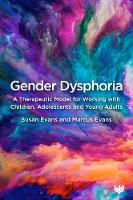Gender Dysphoria: A Therapeutic Model for Working with Children, Adolescents and Young Adults

Book Details
- Publisher : Karnac Books
- Published : 2021
- Cover : Paperback
- Pages : 272
- Category :
Child and Adolescent Studies - Catalogue No : 95310
- ISBN 13 : 9781912691784
- ISBN 10 : 9781912691
Reviews and Endorsements
This book is as thoughtful as it is necessary. Every responsible clinician and therapist who treats children and adolescents must read it – and read it carefully.
Abigail Shrier, journalist and author of ‘Irreversible Damage: Teenage Girls and the Transgender Craze’
I highly recommend this sensitive and timely book to laypersons and professionals who are interested in learning about the complex, controversial, and contemporary subject of gender dysphoria. The authors, Susan and Marcus Evans, are open, compassionate, non-judgemental, and able to tolerate uncertainty in their understanding of those who experience gender dysphoria, are transitioning, or detransitioning. Their psychoanalytically oriented therapeutic model takes into account the individual’s development, family, culture, and political environment. I think the reader will especially appreciate the additional attention paid to the response of adolescents, emotionally unstable personality disordered people, and suicidal individuals to gender dysphoria.
Donald Campbell, past President of the British Psychoanalytical Society and former Secretary General of the International Psychoanalytical Association
Gender dysphoria is increasingly being seen as a part of the spectrum of human diversity. This has resulted in a profoundly reductionistic and decontextualised clinical approach to gender distress. The authors draw on their extensive clinical experience to illustrate how gender dysphoria cannot be understood without understanding the developmental and relational contexts within which it arises. Their detailed case examples document the unique psychic landscapes of people suffering gender dysphoria, illuminating how the ubiquitous “born in the wrong body” conceptualisation can leave vast areas of historical and current lived experience unaddressed. The authors utilise a psychoanalytic lens to understand the experience of both patient and therapist in therapeutic work with gender dysphoria, in a way that is both accessible and insightful. This will be an invaluable reference for those seeking to go beyond the surface to work at depth with gender dysphoria. This work is remarkable for its bravery in presenting a perspective on gender dysphoria that is increasingly being excluded from social and clinical discourse.
Roberto D’Angelo, Training and Supervising Analyst, Institute of Contemporary Psychoanalysis, Los Angeles and President of the Society for Evidence-Based Gender Medicine
This clear, excellent, clinically based account is very timely. It will help those who want to find their way through the confusing and often contentious writings on the subject of gender identity. It is well founded on experience of helping and working with people who do not feel at home in their bodies, particularly in regard to their sexual identity. They bring to the subject an unusual amount of clinical experience of this specialised psychological area. I strongly recommend it to those in the psychological, medical, and social fields, as well as to anyone who wants an informed account of a confused and confusing subject.
Dr Ronald Britton, FRCPsych, Distinguished Fellow, British Psychoanalytical Society
What distinguishes the transgender from the gender dysphoric? Research in this area is not as advanced as we would like, and there is a dearth of good data. While this book does not reflect on gender dysphoric individuals for whom transition may be the right decision and have a positive outcome, it does add a great deal to the argument that careful thought is vital in the process of considering such a move. Transition may, or may not, be in the best interests of the individual. But maintaining a position of neutrality and enquiring curiosity, neither pro- nor anti-transition but pro-thought, is a point repeatedly made by the authors.
Alan Colam, International Journal of Psychoanalysis, 2023, (104)(6):1139-1142

